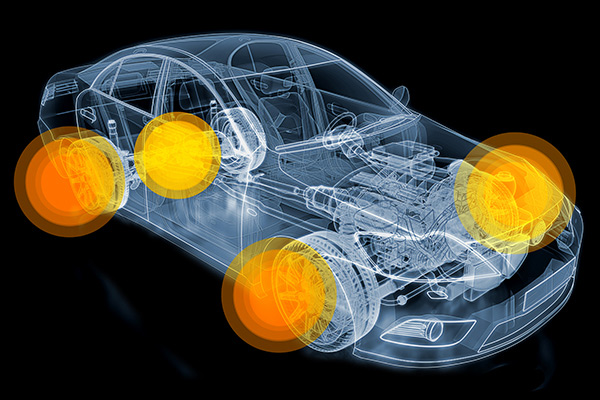If your car is making a chirping noise, it could be due to a worn-out drive belt. This issue usually arises from the accessory drive belt, also known as the serpentine belt, or the timing belt.
Driving with a chirping noise from your car can indicate a potentially serious problem that needs immediate attention. Addressing this issue promptly can prevent further damage to your vehicle and ensure your safety on the road. We will explore the common causes of a chirping noise in your car, how to diagnose the problem, and what steps you can take to resolve it effectively.
Let’s dive in to uncover the source of that pesky chirping sound and find a solution to get your car running smoothly again.
Identifying The Chirping Noise
At some point, you may have noticed a mysterious chirping noise coming from your car. It is essential to address this issue promptly to prevent any potential damage or further complications. By identifying the source of the chirping noise, you can take the necessary steps to fix the problem. In this article, we will guide you through the process of identifying the chirping noise from your car, so you can address it effectively.
Listen Carefully
The first step in identifying the source of the chirping noise is to listen attentively. Find a quiet location, such as an empty parking lot, and start the car. Focus on the sound and try to determine its origin. Is it coming from the engine bay or elsewhere in the vehicle?
Check Engine Bay
Once you have located the general area of the chirping noise, it is time to take a closer look under the hood. Open the engine bay and inspect the components. Look for any loose or disconnected parts, such as hoses or belts. Additionally, pay attention to any signs of wear or damage.
Examine The Drive Belt
A common culprit for chirping noises in a car is a worn or loose drive belt. The drive belt is responsible for transferring power from the engine to various components, such as the alternator, power steering pump, and air conditioning compressor. Carefully inspect the drive belt for any signs of fraying, cracking, or excessive looseness. If necessary, consult your vehicle’s owner’s manual for guidance on how to tighten or replace the drive belt.
By listening carefully, checking the engine bay, and examining the drive belt, you can effectively identify the source of the chirping noise in your car. Remember, addressing the issue early on can prevent further damage and ensure the smooth operation of your vehicle. If you are unsure or unable to identify the source of the noise, it is always recommended to consult a professional mechanic for assistance.

Credit: www.reddit.com
Potential Causes Of Chirping Noise
Experiencing a chirping noise coming from your car can be quite unnerving and may indicate underlying issues that need attention. Let’s take a look at some potential causes of chirping noise that you should be aware of:
Worn Drive Belt
A worn drive belt is a common culprit for chirping noises in cars. Over time, the drive belt can become cracked or frayed, causing it to slip and produce a chirping sound.
Faulty Tensioner
A faulty tensioner can also lead to a chirping noise in your car. If the tensioner is not maintaining the proper tension on the drive belt, it can result in the belt slipping and producing the chirping sound.
Malfunctioning Pulley
A malfunctioning pulley can contribute to a chirping noise in your vehicle. If the pulley is not rotating smoothly or is misaligned, it can cause the drive belt to chirp as it moves over the pulley.
Troubleshooting Steps
If you hear a chirping noise coming from your car, it could indicate a problem with the drive belt system. Fortunately, you can troubleshoot and resolve the issue by following these steps.
Inspect Drive Belt Condition
Begin by visually inspecting the drive belt for signs of wear, cracks, or fraying. Use a flashlight to check for any damage or irregularities along the entire length of the belt.
Check Tensioner Operation
Next, examine the tensioner to ensure it is functioning properly. A faulty tensioner can cause the drive belt to slip or produce a chirping sound. Look for any signs of misalignment or excessive movement.
Examine Pulley Function
Lastly, assess the condition of the pulleys connected to the drive belt. Worn or damaged pulleys can lead to noise issues. Rotate each pulley by hand to check for smooth operation and listen for any abnormal sounds.
Replacing The Drive Belt
When your car starts making a chirping noise, it can be quite unsettling. One common cause of this noise is a worn-out or damaged drive belt. The drive belt, also known as a serpentine belt, powers various components in the engine, such as the alternator, power steering pump, and air conditioning compressor. Replacing the drive belt is a relatively simple maintenance task that can help eliminate the chirping noise and ensure your vehicle’s optimal performance.
Gather Necessary Tools
Before you begin, gather the necessary tools for the job. You will need a ratchet or serpentine belt tool, a socket set, and possibly a diagram of the belt routing specific to your vehicle.
Loosen Tensioner
Locate the serpentine belt tensioner, typically found near the front of the engine. Use the ratchet or serpentine belt tool to rotate the tensioner and release the tension on the belt. Refer to your vehicle’s manual or a diagram for the exact location and procedure for loosening the tensioner.
Remove/install Drive Belt
Once the tension is released, carefully remove the old drive belt from the pulleys. Take note of the belt’s routing to ensure the new belt is installed correctly. To install the new belt, place it over the pulleys following the designated routing. Slowly release the tensioner to apply tension to the new belt, ensuring it is properly seated on each pulley.
Addressing Tensioner Issues
Experiencing a chirping noise from your car can be indicative of tensioner problems, specifically related to the serpentine belt tensioner. To effectively troubleshoot and address this issue, it is crucial to focus on the tensioner as a potential source of the noise.
Check For Tensioner Wear
Inspect the tensioner pulley for any signs of wear or damage. Look for cracks, chips, or any irregularities on the surface of the pulley.
Check the tensioner arm for proper tension and alignment. Ensure it is not loose or misaligned which can lead to belt slippage.
Test Tensioner Function
- Start the car and listen for the chirping noise while the engine is running.
- Observe the tensioner pulley for any shaky or vibrating movements.
- Slowly rev the engine to see if the noise intensifies or changes with the acceleration.
Replace Tensioner If Needed
- If the tensioner shows visible signs of wear or fails the functionality test, consider replacing it.
- Consult with a professional mechanic to determine the correct tensioner replacement for your specific car model.
- Ensure to use quality replacement parts to prevent future issues and maintain optimal performance.
Resolving Pulley Problems
When you hear a chirping noise coming from your car, it can be a sign of a pulley problem. Resolving pulley issues is crucial to prevent further damage to your vehicle. Let’s delve into the steps to resolve pulley problems.
Inspect Pulley Alignment
Begin by inspecting the alignment of the pulley in question. Use a straight edge to check if the pulley is misaligned.
Check For Damage Or Misalignment
Examine the pulley for any signs of damage or misalignment. Look for cracks, worn-out edges, or any other irregularities that indicate a faulty pulley.
Replace Faulty Pulley
If you find any issues with the pulley during your inspection, it’s crucial to replace it promptly. Consult a professional mechanic to determine the exact replacement part needed for your vehicle.
Common Mistakes To Avoid
If you hear a chirping noise coming from your car, this could indicate a loose or worn-out fan belt, pulley, or tensioner. It's important to address this issue promptly to prevent further damage to your vehicle. Be sure to have a professional mechanic inspect and repair the source of the chirping noise to avoid potential long-term problems.
When your car starts producing a chirping noise, it’s easy to dismiss it as a minor annoyance. However, ignoring this sound can lead to serious problems down the line. It’s essential to identify the cause of the chirping and take the necessary steps to fix it promptly. In this article, we will discuss the common mistakes people make when dealing with a chirping noise from their car and provide tips to avoid them.
Ignoring The Chirping Sound
One of the biggest mistakes car owners make is ignoring the chirping sound coming from their vehicle. The chirping noise is usually an indication that something is wrong, and failing to address it can result in costly repairs. It’s important to remember that a small issue can turn into a major problem if left unresolved. If you hear a consistent chirping sound, it’s crucial to investigate the source and take action immediately.
Using Incorrect Belt Replacement
Another common mistake is using an incorrect belt replacement in an attempt to fix the chirping noise. Belts, such as the serpentine belt or the timing belt, can deteriorate over time and start causing noise. However, it’s essential to ensure that you’re using the right belt for your specific make and model of car. Mismatched or improperly installed belts can not only perpetuate the chirping noise but also lead to further damage to the engine. Always consult your vehicle’s manual or seek professional advice to ensure you replace the belt correctly.
Neglecting Tensioner Maintenance
A frequently overlooked mistake is neglecting tensioner maintenance when dealing with a chirping noise. The tensioner is responsible for keeping the belts at the correct tension, and when it malfunctions, it can cause the belts to slip or become misaligned, resulting in a chirping sound. Regular maintenance of the tensioner, including proper lubrication and adjustments, can help prevent the chirping noise from occurring. Make sure to consult your car’s maintenance schedule and follow the recommended maintenance procedures for the tensioner to avoid potential issues.
In conclusion, when it comes to a chirping noise from your car, it’s crucial to address it promptly and avoid common mistakes that can exacerbate the problem. Ignoring the sound, using incorrect belt replacement, and neglecting tensioner maintenance are all mistakes that can lead to more significant issues. By taking the necessary steps to identify the cause of the chirping noise and addressing it correctly, you can help ensure the longevity and performance of your vehicle.

Credit: living.geico.com
Seeking Professional Help
When DIY troubleshooting fails, or concerns about complex repairs arise, seeking professional help is essential.
When Diy Troubleshooting Fails
If the chirping noise persists despite DIY efforts, consulting an expert mechanic is recommended.
Concerns About Complex Repairs
For complex issues like transmission problems, professional assistance ensures proper diagnosis and repair.
Dealing with limited automotive knowledge can be overwhelming when faced with car troubles.
Professional auto technicians have the expertise to identify and resolve chirping noises effectively.

Credit: www.reddit.com
Conclusion
If you hear a chirping noise from your car, addressing it promptly can prevent larger issues. Regular maintenance and timely repairs are key to ensuring smooth rides. Don’t ignore unusual sounds, as they could indicate potential problems. Stay proactive to keep your vehicle running at its best.


